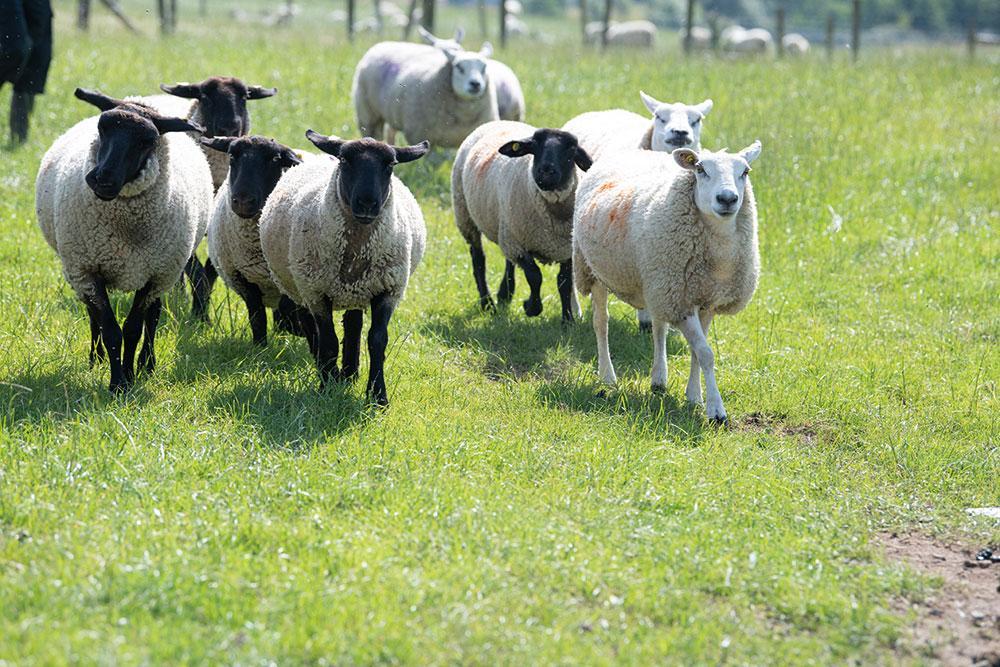20 August 2024
Mixed farming systems: towards sustainability
Integrated crop and livestock farming systems have the potential to provide a sustainable alternative to reduce greenhouse gas emissions and maintain family farm income.

Photo credit: Andrew Downes
Global agriculture is set to tackle economic, environmental and social challenges in order to maintain sustainable food production. Income pressures related to rising input costs, farm management labour requirements and the continuously changing regulatory landscape are among the factors that elevate stress among farm families and reduce their wellbeing.
Consequently, farmers and society must find a balance between sustainability aims. In this context, quantifying the synergies and trade-offs between environmental goals, such as reducing agriculture’s carbon footprint and maintaining farmers’ livelihood, is vital in guiding policy-making and designing adjustment pathways for enhanced sustainability.
European Union authorities have compiled a new climate strategy through the EU Green Deal, which has set ambitious greenhouse gas (GHG) emission reduction targets in all economic sectors of -55% by 2030 and climate neutral by 2050 (see Table 1). In Ireland, the agricultural sector contributes over one-third of national GHG emissions, with ruminant production systems being a key emission driver.
As a result, decarbonisation in the Irish agricultural sector is an important step going forward, with adaptation of farming systems being the sensible strategy ensuring national emission targets are met.
Redeveloping systems
A new Common Agricultural Policy (CAP) Strategic Plan is being implemented by the Irish government to support the production of nutritious and sustainable food while protecting family farm incomes and supporting climate change ambitions.
In this context, the redevelopment of mixed farming systems that integrate crop and livestock enterprises may improve sustainability, exploiting opportunities aligned to Ireland’s CAP Strategic Plan.
Tasos Chatzichristou, a Walsh Scholar at Teagasc Moorepark, explains: “Locally grown feed and organic fertiliser in the form of manure provide a sustainable pathway to shorten supply chains, promote nutrient recycling and minimise input requirements, ultimately promoting farm integration and circularity. Circularity is an array of ecological practices, new technologies, economic models and social services that foster resource reuse, thereby reducing environmental pressures from agricultural production and income risks by exploiting economies of scope – the production of complimentary products.”
Although mixed systems provide a promising avenue for boosting sustainability, they face barriers such as increased requirements in capital, knowledge, infrastructure and management techniques. For operational and financial reasons, production systems on farms in Ireland have become increasingly specialised in recent decades.
Increasingly specialised
Farm mechanisation and the favourable agricultural policy environment transformed farm structures from the historically prevalent mixed crop and livestock model, to product-oriented and specialised, Tasos continues.
“Accordingly, the majority of farms focus on the production of a primary output – milk, for example – taking advantage of economies of scale to achieve lower average costs with higher productivity. Specialisation is capital-intensive, focusing on linear production processes to maximise output efficiency. Linear production refers to the extraction of raw materials from resource rich countries, processing in industrial countries, and shipping to income rich countries, where they are used, discarded and replaced.”
As a result, there is a chance that certain intensive specialised systems might fall short on environmental sustainability targets, due to neglecting material recycling and input minimisation. Consequently, research is needed to understand the impacts of mixed farms in comparison to specialised systems across various sustainability dimensions, and to provide tangible evidence to farmers and policy-makers on their relative strengths and limitations.
Re-Live, a European project funded by Era-Net, promotes the collaboration between research and educational organisations across Europe – such as universities, research institutes and private partners – and is set to tackle questions related to the environmental, economic and societal impact of mixed crop and livestock systems. The Re-Live project aims to answer questions about sustainable food production, introducing a gold standard methodology that will support farmers with management decisions to lower their farm carbon footprint and maintain profitability.
The research programme intertwines work packages that span from on-field research to systems modelling, Tasos explains.
“In that regard, our ongoing research conducted in Teagasc Moorepark, collaborating with University College Dublin, aims to provide a decision support tool for evaluating the economic and environmental performance of farms across Ireland, and test the impact of mixed farm scenarios and land use interventions on environmental, economic and social dimensions.”
Setting a standard
In particular, this provides insight into the impacts of different soil interventions, cultivation practices, manure management, residue utilisation and nutrient upcycling. In broad terms, it is a tool that encompasses and quantifies a series of sustainability concepts implemented by the latest European and Irish Agricultural Policy.
“As modern agriculture faces multifaceted challenges, including greenhouse gas mitigation and economic sustainability, mixed livestock and cropping systems are resurfacing as a potential solution to bridge the gap between linear and circular farming systems,” concludes Tasos.
However, research is still needed to identify the impacts of mixed systems on sustainable food production and it is imperative that initiatives should align with a restructured CAP. As a result, farm integration might be a missing piece to the agricultural sustainability puzzle.
Table 1. Agricultural share of emissions in Europe and Ireland including 2030 and 2050 targets (DAFM, 2023; EPRS – Green Deal, 2021; EU Climate Target Plan, 2020).
| Emissions in Agriculture | Europe | Ireland |
|---|---|---|
| 2023 figures | 10%1 | 37.8% |
| 2030 targets1 | -55% (all sectors)2 | -25% (agriculture)3 |
| 2050 targets4 | -100% | -100% |
1Approximately, European Commission, Climate Action, 2023. 2Emission reduction targets for all economic sectors including agriculture, compared to 1990 emission levels. 3Total agricultural emissions reduction target compared to 2018 emission levels. 4Net zero carbon dioxide equivalent.
Contributors
Tasos Chatzichristou, Walsh Scholar/PhD Student, Teagasc Moorepark/University College Dublin.
Jonathan Herron, Research Officer, Teagasc Moorepark,
Michael Wallace, Professor of Agriculture and Food Economics, School of Agriculture and Food Science,
University College Dublin.
Funding
Teagasc Walsh Scholarships Programme; ReLive project funded by ERA-NET, Department of Agriculture, Food and the Marine.
